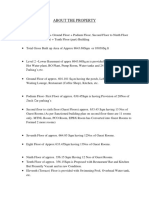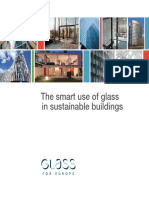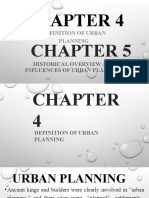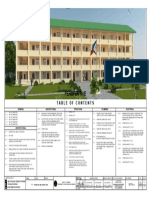0 ratings0% found this document useful (0 votes)
64 viewsQB PSC Unit-I
QB PSC Unit-I
Uploaded by
Manigandan PriyaThe document discusses prestressed concrete, including:
- Prestressed concrete is concrete with internal stresses introduced to counteract external loads. Tendons like steel wires or strands are tensioned to impart prestress.
- Prestressing can be done through pretensioning, by tensioning tendons before concrete is placed, or post-tensioning, by tensioning against hardened concrete.
- High strength steel and concrete are required for prestressing to minimize stress losses from deformation, creep, and shrinkage over time.
- The advantages of prestressing include increased strength, reduced cracking, and allowing for longer spans.
Copyright:
© All Rights Reserved
Available Formats
Download as DOCX, PDF, TXT or read online from Scribd
QB PSC Unit-I
QB PSC Unit-I
Uploaded by
Manigandan Priya0 ratings0% found this document useful (0 votes)
64 views4 pagesThe document discusses prestressed concrete, including:
- Prestressed concrete is concrete with internal stresses introduced to counteract external loads. Tendons like steel wires or strands are tensioned to impart prestress.
- Prestressing can be done through pretensioning, by tensioning tendons before concrete is placed, or post-tensioning, by tensioning against hardened concrete.
- High strength steel and concrete are required for prestressing to minimize stress losses from deformation, creep, and shrinkage over time.
- The advantages of prestressing include increased strength, reduced cracking, and allowing for longer spans.
Original Description:
hi
Original Title
QB PSC UNIT-I
Copyright
© © All Rights Reserved
Available Formats
DOCX, PDF, TXT or read online from Scribd
Share this document
Did you find this document useful?
Is this content inappropriate?
The document discusses prestressed concrete, including:
- Prestressed concrete is concrete with internal stresses introduced to counteract external loads. Tendons like steel wires or strands are tensioned to impart prestress.
- Prestressing can be done through pretensioning, by tensioning tendons before concrete is placed, or post-tensioning, by tensioning against hardened concrete.
- High strength steel and concrete are required for prestressing to minimize stress losses from deformation, creep, and shrinkage over time.
- The advantages of prestressing include increased strength, reduced cracking, and allowing for longer spans.
Copyright:
© All Rights Reserved
Available Formats
Download as DOCX, PDF, TXT or read online from Scribd
Download as docx, pdf, or txt
0 ratings0% found this document useful (0 votes)
64 views4 pagesQB PSC Unit-I
QB PSC Unit-I
Uploaded by
Manigandan PriyaThe document discusses prestressed concrete, including:
- Prestressed concrete is concrete with internal stresses introduced to counteract external loads. Tendons like steel wires or strands are tensioned to impart prestress.
- Prestressing can be done through pretensioning, by tensioning tendons before concrete is placed, or post-tensioning, by tensioning against hardened concrete.
- High strength steel and concrete are required for prestressing to minimize stress losses from deformation, creep, and shrinkage over time.
- The advantages of prestressing include increased strength, reduced cracking, and allowing for longer spans.
Copyright:
© All Rights Reserved
Available Formats
Download as DOCX, PDF, TXT or read online from Scribd
Download as docx, pdf, or txt
You are on page 1of 4
Unit I Introduction Theory & behaviour Two marks
1. Explain the term Prestressed Concrete
Prestressed concrete is basically a concrete in which internal stresses of suitable magnitude and
distribution are introduced so that the stresses resulting from external loads are counteracted to a desired
degree.
2. How the prestressing is imparted into R.C. Structures?
In R.C. Structural members, the prestressing is commonly introduced by tensioning the steel
reinforcement.
3. Explain the principle of prestressing?
The principle of prestressing is that when the system is expected to have tensile stresses due to external
loads, a pre-compression can be given to the system to a desired level even before the application of the
external loads. Then the tension developed due to the external loads will get largely nullified by the
initially applied compression.
Examples (i) force fitting of metal bands on wooden barrels. (ii) pre-tensioning the spokes in a bicycle
wheel.
4. Classify the prestressed concrete structures?
Prestressed concrete structures are broadly classified into two types. They are as follows
(i) Pretensioned prestressed concrete
(ii) Post tensioned prestressed concrete
5. Explain pretensioning and post tensioning in prestressed concrete?
(i)Pretensioned prestressed concrete
Pretensioned is a method of prestressing a concrete in which the tendons are tensioned before the concrete
is placed. In this method, the prestress is imparted to concrete by bond between the steel and concrete
(ii)Post tensioned prestressed concrete
Post tensioned is a method of prestressing concrete by tensioning the tendons against hardened concrete.
In this method prestress is imparted to concrete by bearing action.
6. Define anchorage zone
Anchorage zone is defined as the zone within which the force gets uniformly distributed on to the
structural element.
7. What are Tendons in prestressed concrete?
Tendons are the stretched element used in a concrete member of structure to impart prestress to the
concrete. Generally, high tensile steel wires, bars or strands are used as tendons.
Unit I Introduction Theory & behaviour Two marks
8. What is meant by Anchorage? What are the different types of anchorages used?
Anchorage is a device generally used to enable the tendon to impart and maintain prestress in the
concrete. The commonly used anchorages are
(i)Freyssinet, (ii)Magnel Blaton,(iii)Gifford-Udall,(iv)LeeMcCall,(v)Leonhardt-Baur,(vi) Dywidag,
(vii)Roebling (viii) BBRV systems
9. What is the need for High strength steel and concrete in prestressed concrete?
The early attempts to use mild steel in prestressed concrete were not successful as a working stress
of 120 N/mm
2
in mild steel is more or less completely lost due to elastic deformation, creep and
shrinkage of concrete.
The normal loss of stress in steel is generally about 100 to 240 N/mm
2
, if this loss is to be small
portion of the initial stress, the stress in the initial stages must be very high, about 1200 to 2000
N/mm
2
. These high stress ranges are possible only with the use of high strength steel.
High strength concrete is less liable to shrinkage cracks, and has a higher modulus of elasticity and
smaller ultimate creep strain, resulting in a smaller loss of prestress in steel.
The use of High strength concrete results in the reduction in the cross sectional dimensions of
prestressed concrete structural elements.
With a reduced dead weight of the material, long span becomes technically as well as economically
practicable.
10. What are the materials required for prestressing concrete?
The main materials required are as follows
High strength concrete
High strength steel
11. What is creep and shrinkage of concrete?
The creep in concrete is the progressive increase in the inelastic deformation of concrete under sustained
stress component. Shrinkage of concrete is the contraction of concrete on drying.
12. What are the different stages of loading?
The stages of loading are as follows
Initial loading (i) during tensioning of steel (ii) at transfer of prestress to concrete
Intermediate loading it includes the loads during transportation of the prestressed members
Final loading (i) at service during operation (ii) at ultimate during extreme conditions
Unit I Introduction Theory & behaviour Two marks
13. List the Advantages of prestressing
(i) The section remains uncracked under service loads
Reduction of steel corrosion which increases durability.
Full section is utilized as high stiffness and less deformations
Increase in shear capacity and improved resilience under dynamic and fatigue loading
Suitable for liquid retaining structures and pressure vessels
(ii) High span to depth ratios
Larger spans are possible with prestressing (buildings with large column free spaces)
Reduction in self-weight results in slender section
More aesthetic and more economical sections
(iii) Suitable for precast construction
Rapid construction.
Better quality control
Reduced maintenance
Suitable for repetitive construction
Reduction of formwork
Availability of standard shapes
14. What are the Limitations of prestressing?
Prestressing requires skilled technology hence it is not common as reinforced concrete
The use of high strength materials is costly
There is additional cost in auxiliary equipments
There is need for quality control and inspection
15. What are the types of prestressing?
(i) Source of prestressing force a)hydraulic prestressing b)mechanical prestressing c) electrical
prestressing d) chemical prestressing
(ii) External or internal prestressing
(iii) Pretensioning or post tensioning
(iv) Linear prestressing or circular prestressing
(v) Full, limited or partial prestressing
(vi) Uniaxial, biaxial or multi axial prestressing
(vii) Concentric or eccentric prestressing
Unit I Introduction Theory & behaviour Two marks
16. Compare reinforced concrete and prestressed concrete
In reinforced concrete, concrete and steel are combined such that concrete resists compression and steel
resists tension. This is a passive combination of the two materials
In prestressed concrete, high strength concrete and high strength steel are combined such that the full
section is effective in resisting tension and compression. This is a active combination of the two materials.
17. Define creep co-efficient
Creep co-efficient is defined as the ratio of the ultimate creep strain to the elastic strain.
Creep co-efficient values Age in days
2.2 7
1.6 28
1.1 360(one year)
18. List the losses of prestress
S.No Pretensioning Post tensioning
1
Elastic deformation of
concrete
No such losses if simultaneously stressed the wires but if successively tensioned
there will be a loss of prestress due to elastic deformation of concrete
2
Relaxation of stress in
steel
Relaxation of stress in steel
3 Shrinkage of concrete Shrinkage of concrete
4 Creep of concrete Creep of concrete
5 Friction
6 Achorage slip
You might also like
- Construction TechDocument13 pagesConstruction Techengsam777No ratings yet
- 4th Semester RCC Notes 170745Document32 pages4th Semester RCC Notes 170745Santosh67% (3)
- Reinforced Concrete Buildings: Behavior and DesignFrom EverandReinforced Concrete Buildings: Behavior and DesignRating: 5 out of 5 stars5/5 (1)
- Metsec Steel Framing SystemDocument46 pagesMetsec Steel Framing Systemleonil7No ratings yet
- Husana, Thessaly Aubrey S. - Bt115 - Research No. 2aDocument19 pagesHusana, Thessaly Aubrey S. - Bt115 - Research No. 2aThessaly HusanaNo ratings yet
- PRESSTRESSED CONCRETE DESIGN_092508Document47 pagesPRESSTRESSED CONCRETE DESIGN_092508mremageneralisNo ratings yet
- Provide A Brief History of Prestressed ConcreteDocument8 pagesProvide A Brief History of Prestressed Concretehasif21100% (1)
- Unit-I (Introduction & Methods of Prestressing)Document10 pagesUnit-I (Introduction & Methods of Prestressing)Sasi HoneyNo ratings yet
- Pre StressingDocument5 pagesPre StressingAakriti VermaNo ratings yet
- Figure-Prestressing of Concrete Beams by Mild Steel RodsDocument4 pagesFigure-Prestressing of Concrete Beams by Mild Steel RodsJaneeshVargheseNo ratings yet
- Principles of Reinforced and Prestressed Concrete: Module inDocument46 pagesPrinciples of Reinforced and Prestressed Concrete: Module inHatsuieeNo ratings yet
- V2 I20 10Document7 pagesV2 I20 10Anu PathakNo ratings yet
- Rohit. S. DasariDocument9 pagesRohit. S. DasarirohitNo ratings yet
- Prestresed Concrete Post Tensioning PDFDocument27 pagesPrestresed Concrete Post Tensioning PDFSathya GajjalaNo ratings yet
- PSC Unit-1Document49 pagesPSC Unit-1madhu sreeNo ratings yet
- Prestressed ConcreteDocument123 pagesPrestressed ConcreteArunavNo ratings yet
- 02.prestressed Concrete PresentationDocument15 pages02.prestressed Concrete PresentationAR1941MUBBASHIRA LAKDAWALANo ratings yet
- PDFDocument268 pagesPDFFaisal Nasim0% (1)
- Prestressing Concept, Materials and Prestressing SystemDocument95 pagesPrestressing Concept, Materials and Prestressing SystemTinzar LattNo ratings yet
- Design of Steel Structure: 5. Snow LoadDocument7 pagesDesign of Steel Structure: 5. Snow Loadsuraj kumarNo ratings yet
- Experimental Studies On Reinforced Concrete and Ferrocement BeamsDocument13 pagesExperimental Studies On Reinforced Concrete and Ferrocement BeamsNamsangLimbooNo ratings yet
- DCS2 ..FjDocument11 pagesDCS2 ..Fjaamershaikh071No ratings yet
- Structural Steel Design: DR - Mu'taz K.M Ass. Prof. in Civil EngineeringDocument16 pagesStructural Steel Design: DR - Mu'taz K.M Ass. Prof. in Civil EngineeringSureshbabu NarayanasamyNo ratings yet
- NotesDocument19 pagesNotesvenkatdasNo ratings yet
- Ce DesignDocument6 pagesCe DesignJhona PancitoNo ratings yet
- Prestressed ConcreteDocument12 pagesPrestressed ConcreteDM AndradeNo ratings yet
- Prestress BasicDocument70 pagesPrestress Basickingsaurabh1234No ratings yet
- Prestressed Concrete Design 2020Document21 pagesPrestressed Concrete Design 2020Edzel RenomeronNo ratings yet
- Notes On Prestressed ConcreteDocument42 pagesNotes On Prestressed ConcreteSushant DahalNo ratings yet
- Question & Answer - 20marks ADocument62 pagesQuestion & Answer - 20marks AIswaryaNo ratings yet
- MMBC Prestressed ConcreteDocument1 pageMMBC Prestressed ConcreteNiveditha jNo ratings yet
- Dim - Materi 3 - Material Dan Tegangan Ijin Beton Prategang 2 (1)Document54 pagesDim - Materi 3 - Material Dan Tegangan Ijin Beton Prategang 2 (1)qoyyum.roufNo ratings yet
- RCD PLATE1 IntoductionDocument6 pagesRCD PLATE1 IntoductionEugene TongolNo ratings yet
- CE 327 RConcrete Module 1Document7 pagesCE 327 RConcrete Module 1Niel John BaquilarNo ratings yet
- Assignment 1Document3 pagesAssignment 1Pauline ManzanoNo ratings yet
- 1.introduction To Pre Stressed Concrete StructuresDocument9 pages1.introduction To Pre Stressed Concrete Structures8986103tNo ratings yet
- CieDocument18 pagesCiedrewagsalud86No ratings yet
- 1.1 Purpose Behind Project:: "Prestressing Technique"Document6 pages1.1 Purpose Behind Project:: "Prestressing Technique"MayankMehrotraNo ratings yet
- كونكريت كورس اولDocument181 pagesكونكريت كورس اولمحمد حسن محمد حسنNo ratings yet
- B. Architecture Construction Technology (Ar6013) Contruction Systems Lecture - 2Document10 pagesB. Architecture Construction Technology (Ar6013) Contruction Systems Lecture - 2David BrainardNo ratings yet
- Design of Composite BridgeDocument10 pagesDesign of Composite BridgeHarold Jackson MtyanaNo ratings yet
- CEE - 616 - Prestressed Concrete Structure AssignmentDocument21 pagesCEE - 616 - Prestressed Concrete Structure AssignmentMd. Abu HanifNo ratings yet
- Prestressed Concrete STRUCTURES 1) Advantages of Prestressed ConcreteDocument2 pagesPrestressed Concrete STRUCTURES 1) Advantages of Prestressed ConcreteKannan CrNo ratings yet
- BT 5 Module 2Document4 pagesBT 5 Module 2Sun FlowerNo ratings yet
- Prestressed Concrete - Lecture 1 & 2Document69 pagesPrestressed Concrete - Lecture 1 & 2Banda RajeshNo ratings yet
- Tos Vii Unit 01 & 02dfhtgfijkDocument20 pagesTos Vii Unit 01 & 02dfhtgfijkKanak YadavNo ratings yet
- Ib 39Document19 pagesIb 39Rup JoshiNo ratings yet
- DOC-20241202-WA0019.Document82 pagesDOC-20241202-WA0019.Technical solution'sNo ratings yet
- SV 1Document27 pagesSV 1Syed Imaduddin ZubairNo ratings yet
- RavisewarDocument4 pagesRavisewarjayesh.20jice072No ratings yet
- Design of Prestressed ConcreteDocument61 pagesDesign of Prestressed ConcreteÅyushi ŇayakNo ratings yet
- Module 1 PRESTRESSED CONCRETE Basic ConceptsDocument10 pagesModule 1 PRESTRESSED CONCRETE Basic ConceptsJay BarotNo ratings yet
- PSC Lecture NotesDocument32 pagesPSC Lecture NotesHaider Shah100% (1)
- Ce2404 Pcs NotesDocument49 pagesCe2404 Pcs NotesChockalingamNo ratings yet
- ArealDocument7 pagesArealArchita KajaleNo ratings yet
- Chapter 4 Pre-Stressed ConcreteDocument23 pagesChapter 4 Pre-Stressed ConcreteDdeqz Elina Bueno I100% (1)
- Pre-Stressed Elective EngineeringDocument7 pagesPre-Stressed Elective EngineeringJonas FernandezNo ratings yet
- Prestressed Concrete: 2Nd Semester 2020-2021Document7 pagesPrestressed Concrete: 2Nd Semester 2020-2021Nino MontaNo ratings yet
- Students' Reinforced Concrete Thesaurus: (With Due Reverence To MR Roget)Document5 pagesStudents' Reinforced Concrete Thesaurus: (With Due Reverence To MR Roget)KWUPASENANo ratings yet
- Some Mooted Questions in Reinforced Concrete Design American Society of Civil Engineers, Transactions, Paper No. 1169, Volume LXX, Dec. 1910From EverandSome Mooted Questions in Reinforced Concrete Design American Society of Civil Engineers, Transactions, Paper No. 1169, Volume LXX, Dec. 1910No ratings yet
- Civil-DCI - INDEXDocument3 pagesCivil-DCI - INDEXAnonymous 2Dz4Kq9M7No ratings yet
- About The Property: Project HighlightsDocument2 pagesAbout The Property: Project HighlightsSri-Swami SamarthNo ratings yet
- Water As Element in Landscape ArchitectureDocument24 pagesWater As Element in Landscape ArchitectureShubhaNo ratings yet
- Architecture Engineering College - Aleppo University - Course Syllabus-2002 PDFDocument23 pagesArchitecture Engineering College - Aleppo University - Course Syllabus-2002 PDFmazen1979No ratings yet
- Unit 11 - CHAMBER SERVICEDocument13 pagesUnit 11 - CHAMBER SERVICEMinhhang LeNo ratings yet
- General Notes: Quiruben M. MeraDocument1 pageGeneral Notes: Quiruben M. MeraHighline BuildersNo ratings yet
- Registration Type Contractor Address City-State Phone Email Building (BU) MC DESIGN, 2910 AMBLESIDE LN. RICHARDSON, TX 75082 (214) 500-2844Document131 pagesRegistration Type Contractor Address City-State Phone Email Building (BU) MC DESIGN, 2910 AMBLESIDE LN. RICHARDSON, TX 75082 (214) 500-2844JAGUAR GAMING100% (1)
- The City of Burlington PropertyDocument2 pagesThe City of Burlington Propertyroselena46No ratings yet
- Kontum Indochina Café PDFDocument15 pagesKontum Indochina Café PDFPrachi Agarwal100% (1)
- Use of Quarry Dust As Fine Aggregate in ConcreteDocument8 pagesUse of Quarry Dust As Fine Aggregate in ConcreteOngeriJNo ratings yet
- First Floor PlanDocument1 pageFirst Floor PlanrajaNo ratings yet
- BuildingsDocument1 pageBuildingsSingly DoublyNo ratings yet
- Masonary ChecklistDocument1 pageMasonary ChecklistgtumcwayNo ratings yet
- TAW BookDocument61 pagesTAW BookgratorreNo ratings yet
- The Smart Use of Glass in Sustainable BuildingsDocument68 pagesThe Smart Use of Glass in Sustainable BuildingsLavanya GayamNo ratings yet
- Planning 3 Chapter 4Document62 pagesPlanning 3 Chapter 4Mae Puyod100% (2)
- Basement First Floor Ground Floor: BED LAB 12'X8.5' BED BED BED BED Bed Room 12.5'X8.5' Kitchen 12'X8.5'Document1 pageBasement First Floor Ground Floor: BED LAB 12'X8.5' BED BED BED BED Bed Room 12.5'X8.5' Kitchen 12'X8.5'AslamMakandarNo ratings yet
- D1D2-MAR-A-0348 Rev.00Document54 pagesD1D2-MAR-A-0348 Rev.00francisbautistaNo ratings yet
- Inspection, Appraisal, Repairs and Maintenance of BuildingsDocument7 pagesInspection, Appraisal, Repairs and Maintenance of Buildingsnalakasa100% (1)
- Unit of Measurement Table_Document8 pagesUnit of Measurement Table_good00786786No ratings yet
- Road ActivitiesDocument6 pagesRoad Activitiesprasanna sNo ratings yet
- Rev 01 Part - 1 Structural Drawing 202012225Document6 pagesRev 01 Part - 1 Structural Drawing 202012225Aung Thit LwîñNo ratings yet
- Structual Plan 2-Storey ResidentialDocument9 pagesStructual Plan 2-Storey ResidentialMark Christian EsguerraNo ratings yet
- Earth ShelteringDocument9 pagesEarth Shelteringanushkamane.1608No ratings yet
- Perspective: Table of ContentsDocument1 pagePerspective: Table of ContentsJunar PlagaNo ratings yet
- 23.10 - Material A.R LogDocument4 pages23.10 - Material A.R LogsyedAtifNo ratings yet
- 109 B, Hill Street, Garnethill, Glasgow, Lanarkshire, G3 6TYDocument4 pages109 B, Hill Street, Garnethill, Glasgow, Lanarkshire, G3 6TYkumar.arasu8717No ratings yet
- Building Rebar InspectionDocument41 pagesBuilding Rebar Inspectionjackcan501No ratings yet
- FW Devoe and Co Factory 110-112 Horatio Street LPC ReportDocument19 pagesFW Devoe and Co Factory 110-112 Horatio Street LPC ReportAlexandrè DávinsonNo ratings yet

























































































